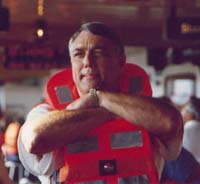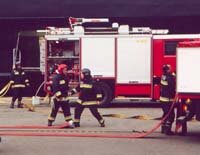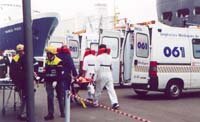Cruise Travel Safety & Security
Mustering, Safety & Your Crew
 Muster: "To assemble the passengers and/or crew on a ship."
Muster: "To assemble the passengers and/or crew on a ship."
Muster Station, Lifeboat Drill, General Emergency Stations, Compulsory Coast Guard Drill... no matter what terminology is used, this exercise is mandatory and required by law.
On any cruise ship, wherever in the world you might happen to embark, one of the first things you'll notice in your stateroom are the bright orange Mae West-style Personal Flotation Devices (PFD) or life jackets. Nervous quips begin to fly, "What's this? You mean I just boarded this ship and now they tell me it might sink?" Well, yes. Unpleasant and unlikely as that may seem, cruise lines take the safety of their guests and vessels very seriously; however, ships have been known to founder.
While you're checking your stateroom's amenities (and marveling at how much bigger it seemed in the brochure's illustration) take a moment to study the emergency card on the back of the door. They differ, ship by ship, but usually indicate "you are here"--the location of your cabin--and the direction you should go in case of an actual emergency. Your muster station will be indicated, usually by number or letter.
Shortly before sailing, an announcement will be made and the lifeboat drill begins when the alarm bells are sounded. Be prepared with your PFD in hand and proceed to your muster station. Carry the life jacket and be sure the ties don't trail on the floor; it's easy to get tripped up on them as you ascend or descend stairs. Crewmembers will be stationed at the stairwells on each deck to give directions. Procedures vary--on some cruise lines you'll muster in a public room to receive instructions and then continue to the lifeboat station, on others you will immediately go to the muster station on an open deck.
In all cases, crewmembers will be on hand to check your stateroom number off their list and show you how to properly put on your PFD. You'll notice it has two important features, a light that is activated in water and a whistle. An officer assigned to your boat will instruct the group on the procedures to follow if it becomes necessary to actually lower and enter the lifeboats or jump into the water.
Roll is taken or stewards check the cabins to make sure that everyone attends. Don't even think about hiding out and not attending the lifeboat drill--in an emergency situation, your survival could depend on it.
Man Overboard
An extremely fortunate cruise ship passenger once climbed up on a table and fell overboard off the coast of Puerto Rico a few years back. He was fortunate because he reached shore without serious injury. However, it's rare that someone unintentionally falls off a ship. When it happens, the bridge goes into high gear performing a Williamson Turn. The time is recorded on the bridge and the ship is set in motion on a sort of figure-8 turn to go back to the exact spot where the accident occurred. As many eyes as possible immediately are on watch. A rescue boat is launched and, with a combination of skill and luck, the passenger is found.
As part of their constant ongoing training, the crew on our vessel was able to accomplish a man overboard rescue drill in approximately 17 minutes.
 |
|
Barcelona fire crews prepare to extinguish a mock engine room fire
|
Fire Safety
Fire is the most dreaded emergency at sea and prevention is the key to averting disaster. Passengers are admonished not to use travel irons in their staterooms and to be certain that other appliances, such as curling irons, are turned off when not in use. Just as on land, everyone on board should practice normal precautions throughout the vessel with smoking materials and never smoke in bed. Lit cigarettes should never be thrown overboard as they can be drawn into an opening on a lower deck. Never, ever light candles in your cabin.
As important as those considerations are, the three primary fire danger zones on a ship are the laundry, galley, and engine room. For that reason, proper maintenance is essential. Galley ducts are cleaned on a regular basis as are clothes dryer lint traps. Machinery is monitored closely.
Even when docked, a ship's crew can find an engine room fire difficult to control. For that reason, the City and Port of Barcelona coordinated a Simulated Disaster Response drill with a cruise ship at the pier. It was a "fire in the engine room" of the vessel. Soon after passengers debarked for city tours on a dreary November morning, bells and the public address system summoned all crew members to their emergency stations. Within minutes, a cacophony of sirens heralded the arrival of the Barcelona "Bombers" fire fighters and their equipment, escorted by motorcycle police officers for crowd control. The vehicles had barely stopped on the pier when the first wave of non-essential crewmembers poured down the gangway in their bright orange life jackets. Fireboats appeared alongside the ship to back up the fire fighters on land and to pluck "victims" from the harbor waters.
Smoke poured ominously from a lower deck opening at the stern as the simulated fire shot upward through the ship. In short order, a hook and ladder truck was readied to reach the lido deck's "trapped" occupants and fire fighting teams disappeared into the hull, trailed by unrolled hoses. Their efforts seemed chaotic but it was soon apparent that each man knew just where he should be in a complex choreography of duties. Crewmembers on board readied the tender platform facing the harbor and the lifeboats could have been lowered at a moment's notice.
When it didn't seem possible that there were any emergency vehicles left in Barcelona, ambulances arrived and a persistent 'whoop-whoop-whoop' overhead indicated a medi-vac helicopter was hovering above. Emergency Medical Technicians and doctors set up a triage area in the terminal building and were ready as the first "casualties" were brought off the ship on stretchers.
 |
|
Crewmembers carry an injured comrade to a waiting ambulance
|
The "injured" included crewmembers as well as fire fighters suffering from minor lacerations to smoke inhalation and severe burns. Medical professionals stabilized the wounded in the terminal and transferred them to ambulances. The most severely burned victim was wrapped in a gold foil covering and whisked away in the helicopter.
Within an hour, the "fire" was extinguished, the smoke had disappeared, and a light rain fell as participants were re-rolling hoses and cleaning up.
Aftermath
Later, our ship's Safety Officer related that the Simulated Disaster Response exercise went well. While it, like the man overboard drill earlier in the cruise, was scheduled, the exact time of the call for assistance was determined by the Captain and the port authorities and city emergency teams responded within 10 to 15 minutes.
In addition, although passengers are often unaware of it, during our cruise some sort of training was ongoing every day. To keep crewmembers on their toes, safety exercises are sometimes unexpected or they are thrown a curve by a change in the time to test their reaction.
During a Real Emergency
In the case of an alarm:
- Proceed to your muster station.
- If you are in your cabin, bring your PFD; otherwise, don't go back for it as there are extras on the boat deck.
- Remain calm.
As a passenger, your obligation is to follow orders. In an emergency situation, the smiling bartender who earlier served you drinks and traded jokes is now a serious crewmember with a specific assignment to perform. Don't expect any crewmember to be less than professional. Your life depends on it.
Back to Cruise Diva's FOCUS on Safety & Security
Related Articles
- Port Security -- What to expect at your embarkation port and ports of call.
- Identifying Yourself -- If you haven't done it already, isn't it about time to get a passport?
- Stay Safe in Ports of Call -- Getting away from it all shouldn't mean getting into trouble.
- Flying the Friendlier Skies -- New security measures are in place to ease your mind about flights safety.
- Cruise Care -- The ship's Sick Bay. You hope you won't need it but it's comforting to know you can depend on it... if only for a bandage.
- Going "Bare" -- This has nothing to do with sunbathing in the buff. Here's the scoop on protecting your cruise investment and yourself.
- Air & Sea: Solutions for the Landlocked -- The facts about cruise line Air & Sea Programs and missing the boat.
- Insurance -- Cover your bases and insure yourself & your cruise investment.
- Ship Happens -- Bad weather, mechanical problems, and political unrest can set your itinerary and plans adrift.
- Cruising into Hurricane Season -- "Official" hurricane season consumes a full six months of the year. It doesn't have to spoil your cruise.
Cruise News -- The latest information regarding cruise lines and ports.
Photographs © Linda Coffman
More from CruiseDiva.com:
Articles & Advice
Cruise Reviews
Cruise Line Profiles
